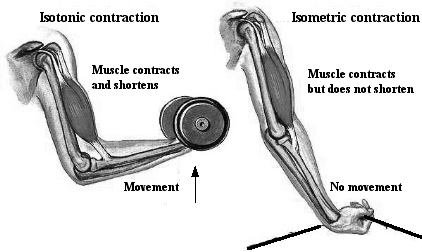Generation of muscle shortening without an increase in tension. Thus, muscle length changes, but tension remains unchanged, with the resultant movement of a body part. Such a voluntary contraction of skeletal muscle, can only happen when the maximal force of contraction generated by a muscle is greater than the external force acting on the muscle. There are two types of isotonic contraction: concentric contractions in which the muscle shortens when it contracts, and as such they are the most common form of contraction in both daily and sporting activities; eccentric contractions are the opposite of concentric ones in that the muscle lengthens as it contracts, thus enabling the deceleration of a body part or object. An example of both contractions being involved in completing an action is provided in kicking a ball: the quadriceps muscle contracts concentrically to straighten the knee while the hamstrings contract eccentrically to decelerate the movement of lower leg. Strength training for children and adolescents by means of isotonic contractions (as well as isometric contractions perhaps to a lesser extent) is topic of continuing debate. The difference between isotonic and isometric contractions is visually summarized in the figure below.
